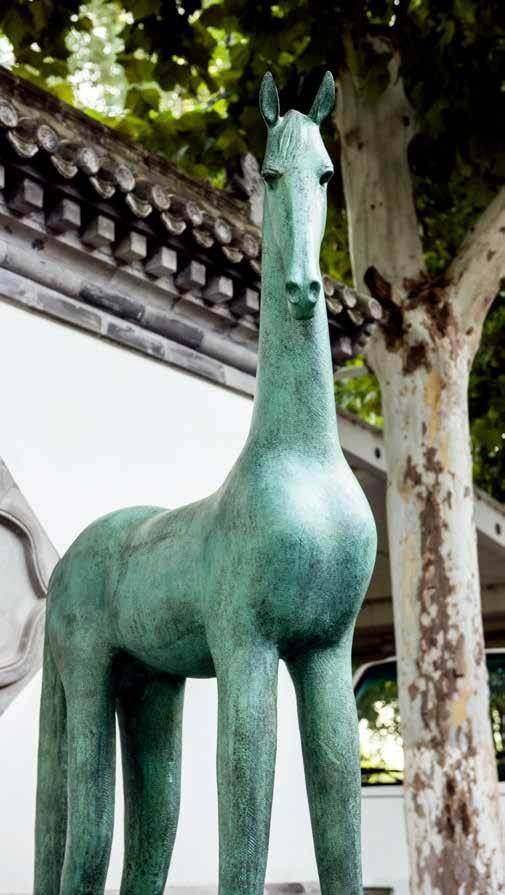The Shape of Horses
2020-02-04byGongHaiying
by Gong Haiying
On September 5, 2020, the“Shiyuan Contemporary Sculpture Nomination Exhibition II: Yu Fans Works at Shiyuan Garden,” sponsored by the Chahar Institute, opened at Shiyuan Garden in Haidian District, Beijing. Away from the hustle and bustle of the city, Shiyuan Garden is home to several elegant sculptures that add an aura of fantasy to the beautiful and quiet courtyard.
Yu Fan obtained a masters degree from the sculpture department of the Central Academy of Fine Arts in 1992 and stayed on as a teacher after graduation. During his many years at the academy, he received considerable education on Western sculpture art. Across the years, he has created many realistic plastic art pieces and developed excellent sculpture skills.
Since 2000, Yu has been pondering“making sculptures disappear.” He pioneered the usage of auto paint spraying technique to color the surfaces of his sculptures with multiple layers of paint in an extremely delicate fashion. And the unique luster of the car paint creates subtle changes of color on the surfaces of his works—shapes seem to disappear into nothing. Since that breakthrough, Yus works have consistently had “true personal appearance and language.”
“Horse” is one of the central themes of Yus sculpture. Of the 10 sculptures at this exhibition, six depict horses. However, it would not be accurate to regard Yu Fan as a “horse sculptor.” “My interest is not the strength of the horse, but its temperament,” Yu explained. “The concept of the horse is ethereal, romantic, and able to transcend reality.”
Using an image from the real world,Yus imagination builds around a foundation rooted in reality. As his techniques developed, Yu gained a wealth of inspirations from Chinas art traditions. For example, the image of Tang Lady at the exhibition was derived from the tricolorglazed pottery of the Tang Dynasty(618-907). The cartoonish innocence captured in the work spilled from Yus own imagination.
“Western sculpture seeks to depict authentic reality, while Eastern sculpture is about imagination.” Yu understands the difference between Eastern and Western sculptures, and as his work has matured, he eventually found “his own space somewhere in the difference between Eastern and Western cultures,” as famous art critic Feng Boyi said.
Yu himself calls his creation “a process of reduction.” He has gradually eliminated many of the techniques he acquired over the years as the subject matter becomes less important for him. He is left with only a pure and simple “sense of juvenile,” as described by renowned contemporary artist Xu Bing. The 10 sculptures featured at this exhibition testify to Yus sculpting skills surpassing those used in realism sculpture. They are not reproduction of concrete reality, but extremely imaginative, ethereal, and transcending creations instead. They seem to have been imported from a world of mythology.
Yus interest has extended beyond sculpture in recent years. In his studio in suburban Beijing, he has produced many small and delicate ceramic works lately. The walls of Yus study are decorated with his own calligraphy and painting including some depicting ancient Chinese characters such as the oracle bone script. He lives and eats alongside his students, and his teaching ceases being confined to classes as it infiltrates daily life.
Art comes from life, not artistic tradition. In this regard, Yu Fan, who is currently exploring calligraphy and painting, is still full of “innovative curiosity.” He continues to explore how to make his work more directly reflect his feelings to place them in a “realm”that embraces all things.